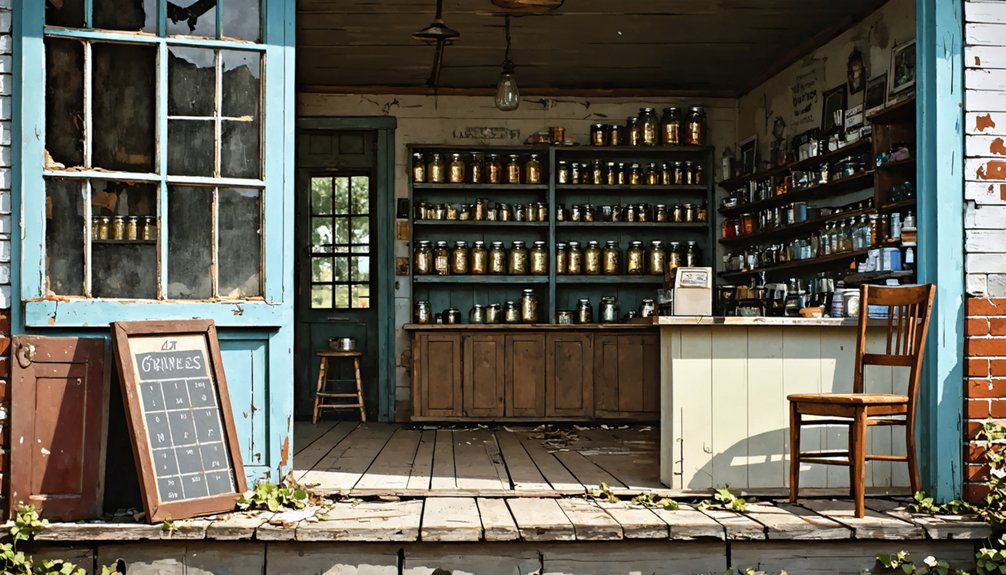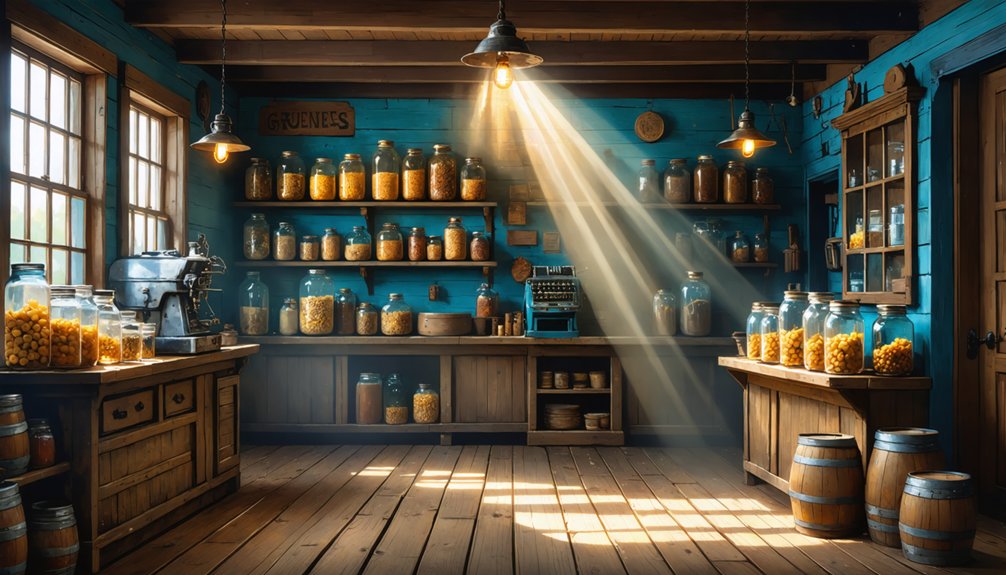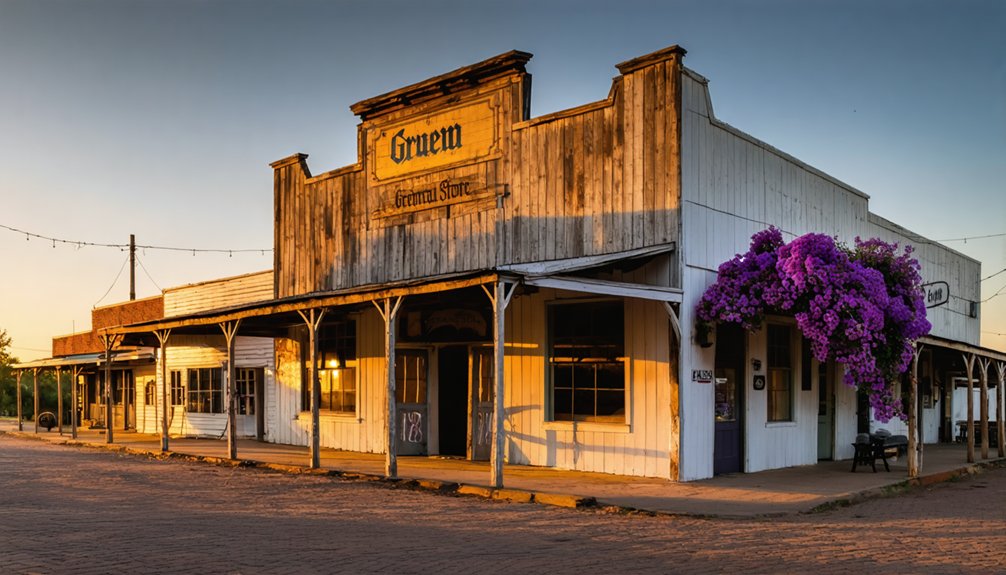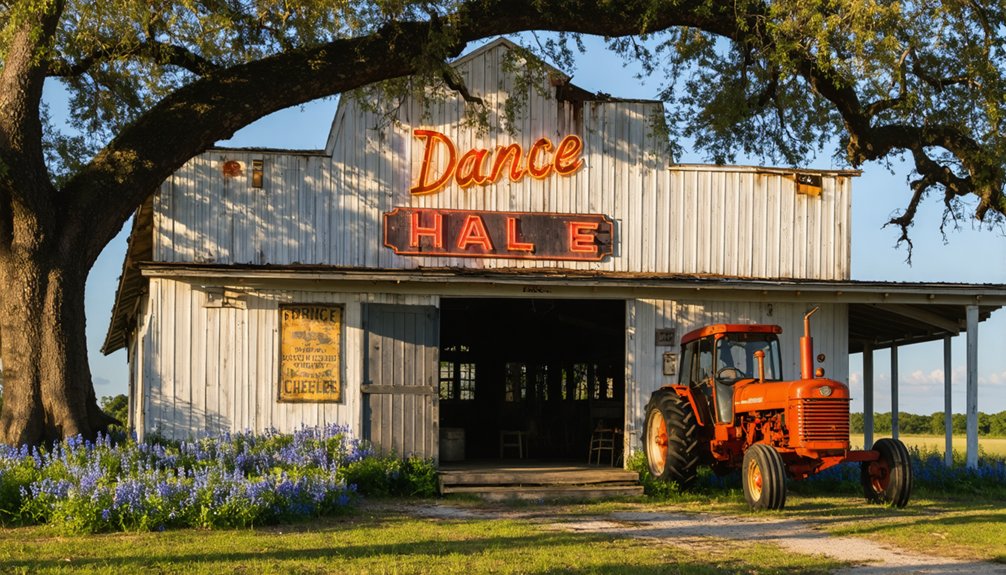When you visit Gruene today, you’ll find a thriving tourist destination that was once a ghost town in the 1950s. This German settlement, founded by Ernst Gruene in 1845, flourished as a cotton empire until the 1920s when multiple calamities struck – including the death of Henry Gruene, a devastating gin fire, and the boll weevil invasion. In 1974, a kayaking architecture student’s chance discovery sparked preservation efforts that transformed these abandoned Victorian buildings into a cherished historic district worth exploring.
Key Takeaways
- Gruene became a ghost town in the 1950s after multiple economic disasters, including the death of Henry Gruene and cotton gin fire.
- The boll weevil invasion devastated cotton crops in the 1920s-30s, contributing significantly to the town’s abandonment.
- Architecture student Chip Kaufman discovered the abandoned historic structures during a 1974 kayaking trip, preventing their demolition.
- The town’s rebirth began in 1975 when Pat Molak purchased Gruene Hall, sparking preservation efforts and restoration.
- Despite its ghost town period, Gruene now thrives as a tourist destination with 1.2 million annual visitors to its historic district.
The German Settlement That Started It All
In the fertile valley of the Guadalupe River, German settlers laid the cornerstone for what would become the historic town of Gruene, Texas. The story of this settlement begins with Ernst Gruene, who arrived in 1845 during a massive wave of German immigration to Texas.
When you trace the settlement patterns of these pioneering families, you’ll find they were part of a larger movement organized by the Adelsverein. Today, researchers often consult disambiguation page records to differentiate this Gruene from other similarly named locations.
Ernst Gruene, finding limited land in nearby New Braunfels, purchased property along the Guadalupe River where he built the area’s first home using traditional German Fachwerk construction. The property was part of the larger Fisher-Miller land grants that German settlers were acquiring in Texas.
Limited land in New Braunfels led Ernst Gruene to establish his Fachwerk home along the Guadalupe River, pioneering Gruene’s first settlement.
His son Heinrich later expanded the settlement by planting cotton and attracting about 30 families to the area. This agricultural foundation transformed the small farming community into a structured town that proudly bore the Gruene family name.
The Rise of a Cotton Empire
Heinrich Gruene’s agricultural vision soon blossomed into a thriving cotton empire that would define the town’s economic identity for generations.
You’ll find that cotton cultivation transformed the landscape along the Guadalupe River, where local farmers worked the fertile soil to produce the region’s “white gold.” By 1878, Gruene had established a water-powered cotton gin, enabling an economic transformation that would shape South Texas for decades. The gin employed continuous monitoring of operations to protect against unauthorized access to the valuable cotton stores. When the original gin burned down in 1922, it was quickly replaced with a modern electric model.
The cotton boom drew sharecroppers and tenant farmers to the area, spurring the development of the Gruene Mercantile and the iconic Gruene Hall.
You can imagine the bustling scenes as flatbed trucks loaded with cotton bales made their way through town, while the gin hummed steadily, processing the precious crop that fueled the community’s prosperity.
Henry Gruene’s Vision and Legacy
When you look at Henry Gruene’s early vision for his Texas settlement, you’ll see a master plan centered on cotton production, complete with a cotton gin, mercantile store, and dance hall that would serve the growing community.
By strategically positioning these buildings near the Guadalupe River and establishing essential infrastructure, Gruene created a thriving agricultural hub that attracted dozens of farming families to the area. His father’s purchase of 6,000 acres laid the foundation for this ambitious development. His first enterprise, the water wheel gristmill, established the town’s industrial foundation.
Though the cotton empire eventually fell to economic hardship and natural disasters, Gruene’s cultural imprint endures through his preserved Victorian architecture and the historic Gruene Hall, which continues to showcase Texas music and heritage to this day.
Building a Cotton Empire
After returning from cattle drives in 1872, Henry D. Gruene established a bold vision for his 6,000-acre plot along the Guadalupe River. You can trace his empire’s beginnings to a water-powered gristmill, but cotton would soon transform this Texas settlement into a thriving agricultural hub.
Gruene’s innovative approach to tenant farming drew 20-30 families seeking opportunity. He offered flexible arrangements – half renters used his equipment for a 50% split, while those with their own tools kept two-thirds of profits. His legacy as the Gruene Cowboy ended with his death in 1920.
His cotton processing operation began with a riverside gin, expanding as production grew. You’ll find his business acumen reflected in the strategic addition of a mercantile store, lumberyard, and blacksmith shop.
A Lasting Cultural Imprint
Henry Gruene’s cotton empire laid more than economic foundations – it planted the seeds of a cultural legacy that would flourish for generations.
Today, you’ll find his vision alive in the preserved Victorian architecture and the authentic Texas spirit that draws visitors from around the world. The National Register listing officially recognizes the historical significance of the Gruene Mansion Inn. Cultural festivals and historical reenactments bring the past to life, while Gruene Hall continues to showcase the best of Texas music, just as it has since the late 1800s. The town became one of the most important cotton-producing centers in Texas during its peak.
- The town’s historic district, protected since 1975, stands as a tribute to preservation efforts led by architecture student Chip Kaufman.
- Gruene Hall remains Texas’s oldest continuously operating dance hall, launching careers of legends like George Strait.
- The Gruene Mansion Inn, Henry’s original home, maintains its Victorian splendor while welcoming modern guests.
When Cotton Was King: The Golden Years
The rich soil along the Guadalupe River transformed Gruene into a cotton powerhouse during the late 1800s, ushering in an era of unprecedented prosperity.
You’ll find cotton cultivation at the heart of every major development that shaped the town’s golden years, from Henry D. Gruene’s strategic land purchase in 1872 to the bustling mercantile store that served local farmers.
The economic impact rippled through the community as cotton production spurred rapid growth.
By the 1880s, you’d have seen up to 30 sharecropping families working the fertile fields, while the river-powered cotton gin processed their harvests.
The International-Great Northern Railroad‘s arrival boosted cotton trade further, cementing Gruene’s position as a thriving agricultural hub.
Gruene Hall, opened in 1878, became the social heart where cotton farmers gathered after long days in the fields.
From Bustling Hub to Abandoned Town

While cotton had fueled Gruene’s meteoric rise, a perfect storm of calamities in the 1920s and 1930s shattered the town’s prosperity. The economic downturn began with Henry D. Gruene’s death in 1920, followed by the devastating cotton gin fire in 1922. When the boll weevil invaded local cotton fields, it dealt another crushing blow to the town’s livelihood.
- The Great Depression accelerated community abandonment, leaving only Gruene Hall operating while the population plummeted to 75 residents by 1930.
- Post-war highway construction bypassed the town entirely, cutting off crucial transportation links that had once made Gruene a bustling hub.
- By 1950, you’d have found a ghost town where empty buildings stood as silent witnesses to the once-thriving community, waiting two decades for their eventual rediscovery. Thanks to a determined architecture student’s documentation, these historic structures would eventually gain protection through the National Register of Historic Places.
A Kayaker’s Discovery Changes Everything
During a fateful kayaking trip down the Guadalupe River in 1974, architecture student Chip Kaufman stumbled upon Gruene’s forgotten treasures – including its iconic water tower, cotton gin, grist mill, and the legendary Gruene Hall.
You wouldn’t believe it, but this kayaking adventure changed the course of history for this Texas ghost town. When Kaufman discovered developers planned to demolish these historic structures for a housing project, he sprang into action.
Working with Pat Molak, Mary Jane Nalley, and the Texas Historical Commission, Kaufman launched a historical preservation campaign that saved Gruene’s soul.
They parceled out properties to preservation-minded owners, with Molak purchasing Gruene Hall in 1975. Their efforts transformed a forgotten ghost town into one of Texas’s most cherished historic destinations.
Preserving Texas History One Building at a Time

From its listing on the National Register of Historic Places in 1975, Gruene’s remarkable preservation story showcases how dedicated individuals saved more than 15 acres of historic Texas architecture from demolition.
You’ll discover how architecture student Chip Kaufman’s vision, combined with developers Pat Molak and Mary Jane Nalley’s investment, transformed this ghost town through innovative preservation strategies and community engagement.
- Gruene Hall, Texas’ oldest continuously operating dance hall, still stands with its original tin roof and open-air design.
- The cotton gin found new life as The Gristmill River Restaurant & Bar, blending historical charm with modern dining.
- The Gruene Mercantile Building’s restoration maintains its role as a community hub, just as it did in 1904.
These preservation efforts didn’t just save buildings – they created a living, breathing community that honors Texas heritage while embracing progress.
Gruene Hall: Where Music Never Died
Since 1878, Gruene Hall has pulsed with the heartbeat of Texas music, earning its place as the state’s oldest continuously operating dance hall.
You’ll find its original 6,000-square-foot dance floor and tin roof still intact, thanks to Pat Molak’s preservation efforts when he purchased the hall in 1975.
Step inside, and you’re walking through the same doors that welcomed German farmers, cotton workers, and legendary performers like Willie Nelson and George Strait.
The hall’s open-air design, with its side flaps and front bar, creates an authentic atmosphere that’s transported visitors back in time for generations.
Today, you can experience Texas musical heritage firsthand as live music fills the historic venue daily, where both emerging artists and established stars keep the tradition alive.
A Modern Tourist Haven in Historic Settings

Today’s Gruene blends its rich heritage with modern tourist amenities, creating a vibrant destination that attracts over 1.2 million visitors annually.
You’ll discover a perfect balance of historical charm and modern attractions across the 15-acre National Historic District, where preserved German-Texan architecture houses contemporary shops, restaurants, and wellness services.
- Float the Guadalupe River with Rockin’ R River Rides, then unwind at Gruene Day Spa for a relaxing massage.
- Shop at authentic venues like the 1925 General Store while sampling local treats at Great Texas Pecan Company.
- Savor Texas Hill Country cuisine at The Gristmill while overlooking the river, or grab coffee at Gruene Coffee Haus.
Every corner of Gruene tells a story, inviting you to experience both its preserved past and comfortable present-day offerings.
Frequently Asked Questions
What Was the Population of Gruene During Its Peak Years?
You’ll find that population trends peaked at 150 residents during the early 1900s, marking a time of historical significance when roughly 30 families thrived through cotton farming activities.
How Far Is Gruene From the Guadalupe River?
You’ll find Gruene sits right on the Guadalupe River’s banks – it’s a zero-mile journey to reach river activities and scenic views. That’s why local outfitters can get you paddling or tubing within minutes.
When Did Gruene Officially Become Part of New Braunfels?
In Gruene’s rich history and development, you’ll find that 1979 marked its official annexation into New Braunfels, transforming from an independent historic district into a cherished neighborhood preserving its unique character.
Are There Any Reported Ghost Stories or Hauntings in Historic Gruene?
You’ll find several haunted locations, including Gruene Hall where benevolent spirits dwell, and a historic church home to “Miss Margaret” and Bill’s ghost. Local ghost tours highlight these supernatural residents.
What Is the Average Annual Temperature and Rainfall in Gruene?
Like a gentle Texas two-step, you’ll experience climate patterns averaging 71°F yearly, with seasonal variations from 53°F to 85°F, while rainfall dances between 34-42 inches annually.
References
- https://texastimetravel.com/directory/gruene-historic-district-tour/
- https://texashillcountry.com/gruene-tx-a-story-of-second-chances/
- https://meetingsmags.com/texas/tx_places/tx_destinations/gruene-historic-district-brings-history-into-the-modern-age/
- https://www.gruenetexas.com/history/
- https://rioguadaluperesort.com/gruene-texas-fun-facts/
- https://www.tshaonline.org/handbook/entries/gruene-tx
- https://texashighways.com/issue-archives/the-scene-in-gruene/
- https://www.texasescapes.com/TexasHillCountryTowns/Gruene-Texas.htm
- https://en.wikipedia.org/wiki/Gruene
- https://www.kueblerwaldrip.com/new-braunfels.htm



